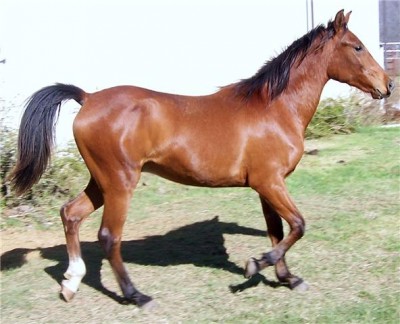Photo of the day: Hamdani yearling from Saudi Arabian lines in Texas
This morning Troy Patterson of Texas sent a few pictures of a yearling colt of his. The colt is by the Ubayyan stallion Zairafan (Alwal Bahet x Maarah by Taam-Rud) and out of the Canadian-bred Hamdaniyah Simriyah mare Saideh (Bahri x Qaisumeh by Qaisum). Below is one such picture.

In the USA and Canada, these horses are called BLUE STAR (with the caps). While I don’t adhere to this denomination (BLUE STAR = no recorded Ma’anaghi strain in the pedigree), and don’t buy into the underlying assumptions (e.g., recorded Ma’anaghi blood = not pure) behind such a denomination, I love these horses, and value them for what they are: real horses straight from the heart of Arabia Deserta, straight from the stables of the House of Saud. The antecedents of these horses were in their original desert homeland as late as the 1960s.
I feel that horses such as this yearling would bring new strength and stamina to many of the older lines of asil Arabians (e.g., the Egyptian lines).
Well there’s no doubt the general list of ,”purebred,” Arabs in the U.S. could certainly benefit from a strong injection of substance in legs, loin, and bone.The U.S. horses though seem to have the ,”prettier,” heads- but what use is pretty if the horse is of no use because his legs are like toothpicks, he can’t tuck his pelvis to lift his back and carry a rider properly, and he’s mentally unstable to the point of being dangerous?
The more I learn about these straight desert (Saudi & Bahraini lines) Blue Star horses, the more impressed I have become with them. Troy’s colt is an outstanding individual, and the rest of her herd matches his quality.
Thanks Jenny.
Edouard, your a doll.
Bruce Peek-Im choosing to believe that you are not implying that the peninsula(saudi Arabia)/blue stars(USA) are slight boned, with bad legs,loins and dispositions. However if by some remote chance that is what you meant, I know that you have never once met any of these horses in the flesh because those traits you referenced, by and large are actually their best qualities.
Actually, I think Bruce Peek meant exactly the opposite – ie that horses such as your colt have good legs, good loins, and good dispositions.
I think you are right, Edouard. I took Bruce’s post as meaning he thought these horses had the bone, back and balance, and disposition to be worth using to improve the breed.
I think Bruce’s comments were positive on Troy’s horse…. that they would improve the deficiencies mentioned.
However, Edouard, I would comment on your interpretation of Blue Star, ie “While I don’t adhere to this denomination (BLUE STAR = no recorded Ma’anaghi strain in the pedigree), and don’t buy into the underlying assumptions (e.g., recorded Ma’anaghi blood = not pure) behind such a denomination…”
That is a bit harsh and involves some extrapolation on your part that digresses from the Blue concept.
I think that the Bedouin of the Nejd would not breed to a horse of which they did not know All of the background. that is the point, and what is mentioned in the Blue Catalog, ie that there is the possiblity of unknown origin Managhi in the background of some horses, and therefore, this very small group of horses cannot take the chance of an admixture of those lines.
As Miss Ott said, and I paraphrase, if we do not mix our horses with those lines, no one is hurt. However, if we mix in those lines and the unknown origin turns out as not asil, then all is lost.
It is quite simple and a concept that has guided Nejd breeding for centuries. It is a most strict adherance to knowing the horses and their breeders.
Edie
If you will look at what i said- that the general list horses here in the U.S. needed more bone- a functional coupling, and trustworthy trainable dispositions it is very clear there was no criticism expressed or implied of real asil desertbreds. I went on to state the obvious-and will slightly reword it so as to form the basis of a discussion. It is clear that the U.S. AHA, if it has any pretence of its real duty to the Arabian horse should immediately set about importing Saudi, or perhaps Syrian Asils , or failing that begin shipping semen from the countries of the middle east where Asils are still being bred- with a goal of breeding ,” Arabianess,” back into the Arabians which it has presided over for the past 40 years with its illgotten show system.
Thank you Bruce clarifying your outlook on the subject. I totally agree with you. :o)
Hi Edie, I have a lot to say on the issue, and would like to dedicate a special post to discuss it at length. Meanwhile, I just wanted to acknowledge your post.